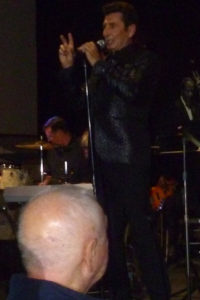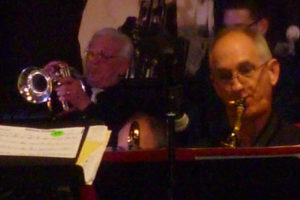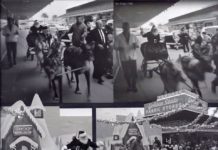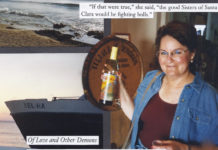
Before there was Elvis, Bobbysoxers in the early 1940s were screaming for Frank Sinatra. World War II was raging, but on the Homefront, it was the era of Big Band music and ration books.
On January 19, 2020, at Dizzy’s in Arias Hall behind the Musicians’ Association building on Morena Boulevard, 80-year-old band leader Rey Vinole turned over his baton to Ray Fisher to ensure the Big Band jazz sound will survive in San Diego.
That is a figure of speech, because Vinole doesn’t use a baton. He looks and moves more like a third base coach giving signals to his team.
Ever upbeat, 92-year-old Johnny Pernicano arrived early with all the enthusiasm of a 1940s Bobbysoxer.
For over 60 years at his pizza house between Pacific Beach and La Jolla, Johnny’s smiling presence was found on the piano bench as he tickled the ivory for his customers.
“I love the Big Bands. I love Rey. I can’t wait for the concert to start,” said Pernicano who insists that he sat front row in the Mission Bay High School auditorium for a Count Basie concert arranged by Vinole.
In the 1950s, Rey Vinole wrestled and played baseball at Mission Bay High School, but music was his first love. During his opening remarks at the concert, he mentioned fellow Mission Bay classmates who gained fame as musicians including Frank Zappa and Clairemont’s Ron Bushy. After graduation, Vinole joined the Navy and played in the Navy Band. “It was the best educational experience I ever had,” he told the crowd.
Supported by his wife, Caroline, Vinole went to the University of Arizona and eventually returned to Mission Bay as the band leader in 1976. Teachers who remembered him shook their heads. He shook his head right back at them. “I didn’t have good grades in high school,” he laughed.

The house was packed at Dizzy’s. Mission Bay alumnus and current California State Board for Equalization member Mike Schaefer was prominently seated in the front row.
Vinole shared warm and personal stories about the various musicians in the band. The keyboard player is blind and sang “All of me.” She also performed her own version of Ella Fitzgerald scat singing. Nobody on the stage was having more fun than her.
The saxophone soloist has survived three serious throat cancer operations that resulted in the loss of teeth and jawbone. Every time, he came back to play.
It was difficult to get the names of band members, because they barely know one another. It’s the music that brings them together. It is music that gives them expression.
During intermission, drummer Alden Merrill introduced his wife to Vinole. She thanked the band leader for giving her husband the opportunity to play with a group of talented musicians.
Barry Allen Cohen has fashioned the classic vintage look of a Vegas lounge crooner. When asked to describe his outfit, Brook Eldridge, an East County dilettante, interrupted, “He’s Sinatra, ’55.” Cohen sheepishly smiled and said, “I’ll go with that.”
Vinole lamented the growing prominence of synthesizers, which has eliminated jobs for musicians. He also predicted A.I. (artificial intelligence) will drastically change the sound of music in the future.
Is A.I. really capable of creating the complex, often improvised arrangements of the Big Band era?

Could artificial intelligence ever write lyrics like, “Mairzy doats and dozy doats and liddle lamzy divey A kiddley divey too, wouldn’t you?” or later, “Who put the bomp in the bomp bah bomp bah bomp Who put the ram in the rama lama ding dong?”
In a serious vein, A.I. never could produce standards like “In the Mood,” “Night and Day,” “Begin the Beguine,” “Sentimental Journey,” “All of me,” “Chattanooga Choo Choo,” “Take the A Train” or “Stardust.”
Beautiful, beautiful music was born during the Big Band era.
Thank you, Rey Vinole, for preserving it. Thank you, Art Fisher, for keeping it alive.



